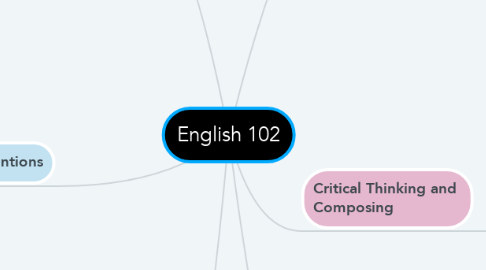
1. Conventions
1.1. 4B. Look back and understand why different texts have different styles and why the organizations vary
1.1.1. Looking at our degree's style of writing and comparing it to popular articles that have different mechanics of writing
1.1.1.1. https://docs.google.com/document/d/14YCZTGIQfcJ1zhO2O4Ld80Dm-cOUMzZi83vvztc3_Cc/edit
1.2. 4C. Understand multiple formats of writing and be able to effectively switch between them in our writing
1.2.1. Learn how to structure paragraphs that are effective in rhetorical analysis
1.2.1.1. https://docs.google.com/document/d/14YCZTGIQfcJ1zhO2O4Ld80Dm-cOUMzZi83vvztc3_Cc/edit
1.2.2. Structure the annotated bibliography using the format of summary, rhetorical analysis, and then critical analysis while having citation as the header
1.2.2.1. https://docs.google.com/document/d/1Z-rjfdmTMlNzKfSRau3tXsOyF29qxuu6517b07kR5RE/edit
1.2.3. Write out a personal narrative and history towards our issue and then transition towards an argumentative paper in project 3
1.2.3.1. https://docs.google.com/document/d/1a8LIF53hln09zre7FiJg562F__neKJZEETZZy7h9JjM/edit
1.3. 4D. Familiarize ourselves with the content of others and be able to correctly cite and give credit to the original content
1.3.1. In class discussion on citations and how to properly cite using MLA citations and reference pages
1.3.1.1. https://docs.google.com/document/d/14YCZTGIQfcJ1zhO2O4Ld80Dm-cOUMzZi83vvztc3_Cc/edit
1.3.2. Create annotated bibliography and know how to properly cite both articles and quotes using APA citation style
1.3.2.1. https://docs.google.com/document/d/1Z-rjfdmTMlNzKfSRau3tXsOyF29qxuu6517b07kR5RE/edit
1.3.3. Format our argument in project 3 using sources and correctly cite them using MLA style format
1.3.3.1. https://docs.google.com/document/d/1a8LIF53hln09zre7FiJg562F__neKJZEETZZy7h9JjM/edit
2. Reflection and Revision
2.1. 3A. revise and improve revision strategies to fit modern tools such as computers.
2.1.1. Rewrote project 1 multiple times using multiple drafts and used computers to aid in grammar and citation strategies
2.1.1.1. https://docs.google.com/document/d/1DGx2UBmJYdOuz24kptsf3yGDn208uE8WE7BaQKBRoNM/edit
2.1.2. Created multiple drafts and filled in citations of APA format using online citation formats for the annotated bibliography
2.1.2.1. https://docs.google.com/document/d/1mNRKQVj9iRCQMfEBuBMO-nmH2PpYpwpTeR4Ngr815Hc/edit
2.2. 3D. understand and locate the social and team related components of the writing process.
2.2.1. Peer review with peers during class sections on Project 1 drafts
2.2.1.1. https://docs.google.com/document/d/1BkJFywjN5ETOoTXlUb6rCz6nboIwh1o6pMOUjkqnF3g/edit
2.2.2. Completed peer review with partner using review sheet to get outside perspective on paper and possible fixes that could be made
2.2.2.1. https://docs.google.com/document/d/15DUhwvD_NRxTjLwFj9ibESs2tolQbuyb3AbYnes-r58/edit
3. Thesis
3.1. compose an effective and argumentative thesis.
3.1.1. Journal 6 and forming a thesis for our argumentative essay
3.1.1.1. https://docs.google.com/document/d/1dzWL5Azl8TyL0in1fpgOOt73Qsrp4ae-ohTugJKi5j4/edit
3.1.2. Creating a sturdy thesis for project 3
3.1.2.1. https://docs.google.com/document/d/1a8LIF53hln09zre7FiJg562F__neKJZEETZZy7h9JjM/edit
3.2. make a nice flowing introduction to argument without running on forever.
3.2.1. Journal 6 and forming a thesis for our argumentative essay
3.2.1.1. https://docs.google.com/document/d/1dzWL5Azl8TyL0in1fpgOOt73Qsrp4ae-ohTugJKi5j4/edit
3.2.2. Introduce my argument from project 3 and then transition it into my personal story in a small paragraph
3.2.2.1. https://docs.google.com/document/d/1a8LIF53hln09zre7FiJg562F__neKJZEETZZy7h9JjM/edit
4. Rhetorical Awareness
4.1. 1B. analyze how the parts of a rhetorical situation can affect the way the writer creates his text and in turn better our understanding of different texts
4.1.1. Interview with Professor in AME
4.1.1.1. https://docs.google.com/document/d/1WODjGpWAlC3c_sg8TakLquAqzQsqFiveNKTxOwq-ZTM/edit
4.1.2. Rhetorical analysis of all sources in annotated bibliography
4.1.2.1. https://docs.google.com/document/d/1Z-rjfdmTMlNzKfSRau3tXsOyF29qxuu6517b07kR5RE/edit
4.2. 1E. compose writings that can respond to different rhetorical situations that include multiple variations in content
4.2.1. Content Response Journals for scholarly articles by our interviewee in our major
4.2.1.1. https://docs.google.com/document/d/18PwS7E5AC82MpZjks2VH4SOd97J2d3F364ibxtOY9Vg/edit
4.2.2. Scholarly articles had critical analysis writings that were filled with our opinion of the article
4.2.2.1. https://docs.google.com/document/d/1Z-rjfdmTMlNzKfSRau3tXsOyF29qxuu6517b07kR5RE/edit
5. Critical Thinking and Composing
5.1. 2A. learn to research both primary and secondary sources so that they may provide questions to answer.
5.1.1. Find scholarly articles that were primary articles to answer the question of how people in our degree write
5.1.1.1. https://docs.google.com/document/d/18PwS7E5AC82MpZjks2VH4SOd97J2d3F364ibxtOY9Vg/edit
5.1.2. Project 1 popular sources are usually secondary sources while scholarly articles were primary sources
5.1.2.1. https://docs.google.com/document/d/18PwS7E5AC82MpZjks2VH4SOd97J2d3F364ibxtOY9Vg/edit
5.1.3. Find scholarly articles and popular sources for our annotated bibliography
5.1.3.1. https://docs.google.com/document/d/1qtjrQGyuxyAHd6yZZIVV6QpbOCDNlXprKx2jLEE-HcE/edit
5.1.4. Find articles on the history of my issue for project 3
5.1.4.1. https://docs.google.com/document/d/1r_yRaIlzMQ4RXYatu9B3Ut-wbA-xCKEsq-5MN9xmPoc/edit
5.2. 2B. analyze sources and determine the usefulness and effectiveness of the sources.
5.2.1. Read our sources and determine if the sources will fit for our degree and check to make sure they are scholarly articles
5.2.1.1. https://docs.google.com/document/d/14YCZTGIQfcJ1zhO2O4Ld80Dm-cOUMzZi83vvztc3_Cc/edit
5.2.2. Determine if our sources for our annotated bibliography provided a side towards our argument on our issue
5.2.2.1. https://docs.google.com/document/d/1qtjrQGyuxyAHd6yZZIVV6QpbOCDNlXprKx2jLEE-HcE/edit
5.2.3. Pick sources that coerce together to form a fluent argument in project 3
5.2.3.1. https://docs.google.com/document/d/1qtjrQGyuxyAHd6yZZIVV6QpbOCDNlXprKx2jLEE-HcE/edit
5.3. 2D. find research sources that can be used in an argumentative environment.
5.3.1. Choosing Scholarly Articles from UA library to be used for our Project 1 based on our Major
5.3.1.1. https://docs.google.com/document/d/14YCZTGIQfcJ1zhO2O4Ld80Dm-cOUMzZi83vvztc3_Cc/edit
5.3.2. Looked for sources that supported our argument and was used in annotated bibliography and argument paper
5.3.2.1. https://docs.google.com/document/d/1qtjrQGyuxyAHd6yZZIVV6QpbOCDNlXprKx2jLEE-HcE/edit
5.4. 2F. write effective research arguments that pertain to multiple rhetorical situations.
5.4.1. Project 1 paper using rhetorical analysis of each article
5.4.1.1. https://docs.google.com/document/d/14YCZTGIQfcJ1zhO2O4Ld80Dm-cOUMzZi83vvztc3_Cc/edit
5.4.2. Completed critical analysis on each source for annotated bibliography
5.4.2.1. https://docs.google.com/document/d/1Z-rjfdmTMlNzKfSRau3tXsOyF29qxuu6517b07kR5RE/edit
5.4.3. Group together multiple sources into categories with similar rhetorical situations to make a fluent argument
5.4.3.1. https://docs.google.com/document/d/1Z-rjfdmTMlNzKfSRau3tXsOyF29qxuu6517b07kR5RE/edit
6. Sources
6.1. incorporate an effective use of sources inside a document.
6.1.1. Include source material for our annotated bibliography
6.1.1.1. https://docs.google.com/document/d/1Z-rjfdmTMlNzKfSRau3tXsOyF29qxuu6517b07kR5RE/edit
6.2. condense information from sources without eliminating context.
6.2.1. Condense and summarize material for our critical analysis in annotated bibliography
6.2.1.1. https://docs.google.com/document/d/1Z-rjfdmTMlNzKfSRau3tXsOyF29qxuu6517b07kR5RE/edit

